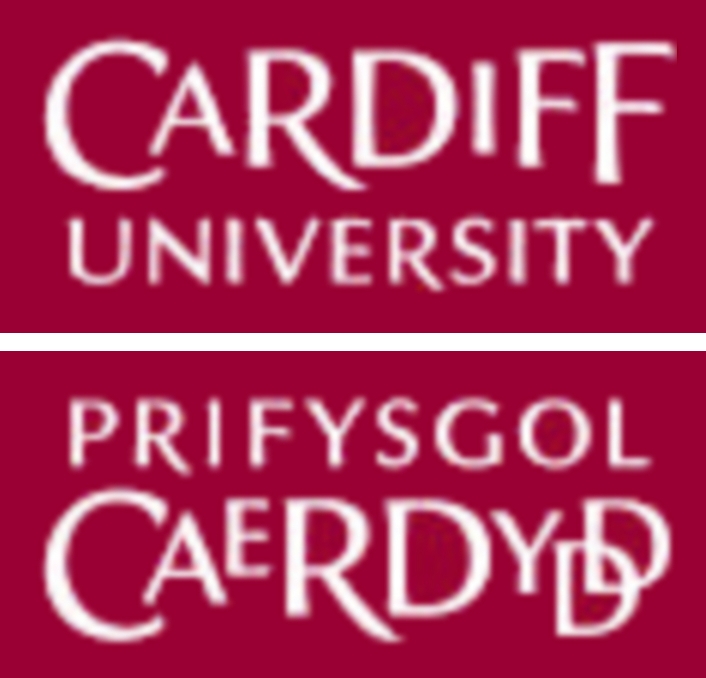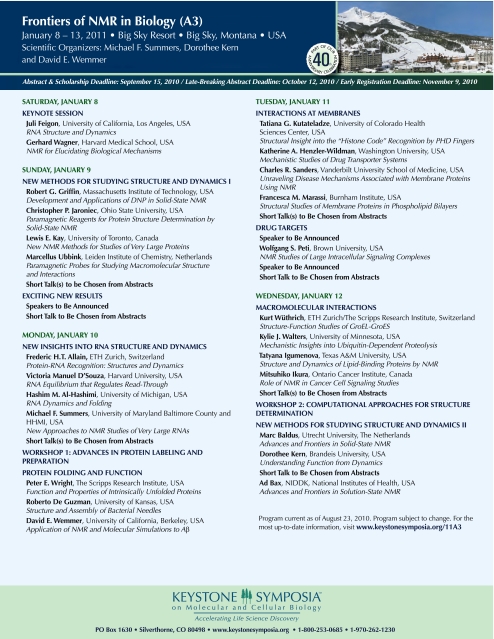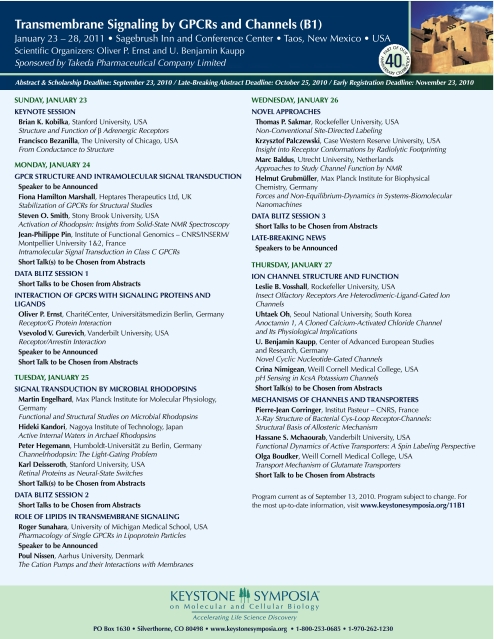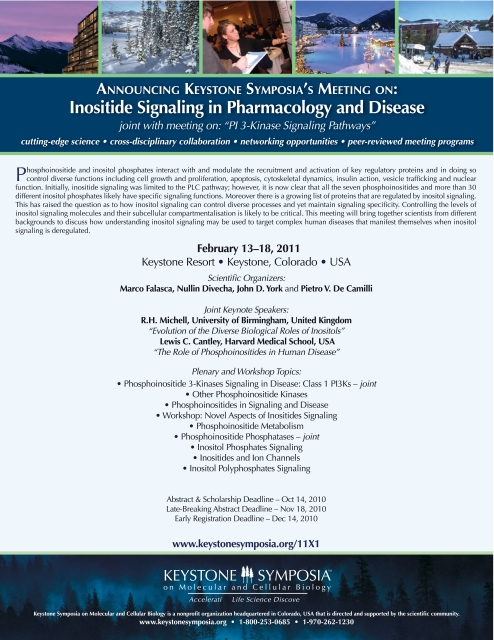Thanks again to all our readers who have submitted items for inclusion in this section. Can I remind you that we advertise readers’ items at the interface of the physical and life sciences free of charge and would welcome any contributions that workers in this area might want to share in this section concerning studentships, job vacancies, courses or conferences, book reviews, or news and comments about recent publications that might be of interest for researchers in the field of Chemical Biology.
Please send to
Dr C A Rosser
1 North Parade
Derby, DE1 3AY
Email: rosserca@hotmail.com
Funded MRC Studentships (tuition and stipend) are Available for MSc Positions Starting Autumn 2010 in the University of Sussex: Imaging in Biomedical Research
http://www.sussex.ac.uk/lifesci/1-4-30-1.html
![]()
![]()

University of Sussex
MSc in Chemical Biology
http://www.sussex.ac.uk/chemistry/chembio
“The recent exciting findings in chemical biology promise a paradigm shift in medical treatments. There is no doubt that some of the most important new scientific advances are in this field and if I were a student today I would be strongly attracted to this field.”Harry Kroto, University of Sussex, Nobel Prize for Chemistry in 1996.
For more information please contact:
School of Life Sciences, University of Sussex, Brighton, BN1 9QG, United Kingdom
Telephone: +44 1273 678057, or email lifesci@sussex.ac.uk
GRADUATE STUDIES IN BILBAO, SPAIN

The University of the Basque Country offers Master and PhD degrees in Molecular Biology and Biomedicine. The 1-year Master degree (60 ECTS) consists of lecture courses (30 ECTS) and a research project (30 ECTS).
No knowledge of Spanish required.
Info at: www.masterbiologiamolecular.ehu.es
MSc in Chemical Biology
Available from September 2009 onwards
Duration
1 year full-time, 3 years part-time
Entry Requirements:
Suitable for graduates in chemistry or a related discipline, e.g. chemistry, biology, microbiology, chemical engineering, physics, pharmacy, pharmacology, and biochemistry, with a First or Second class UK Honours degree or its equivalent.
Course Aims:
The chemistry of biological processes is the basis of all life on the planet. By studying aspects such as biosynthesis, retrosynthetic analysis, molecular biology and the principles of drug development this course will develop an understanding of the pathways that are core to chemical biology. Also, applications of biological catalysts in industrial processes, synthetic methods and spectroscopy will all be suitable for graduates wishing to develop their knowledge and to pursue a career in academia or industry.
Applicants whose first language is not English will be required to demonstrate competency in English.
Futher information from http://coursefinder.cardiff.ac.uk/postgraduate/browse/taught/schools/index.html?school=4
Or contact:
Dr Thomas Tatchell
Tel: +44 (0)29 2087 0759
Email: TatchellT@cardiff.ac.uk
Doctoral Training Centre—Chemical Biology Centre, Imperial College London
The Chemical Biology Doctoral Training Centre (DTC) was set up in 2003 as a result of the innovative lifesciences interface programme established by the Engineering and Physical Sciences Research Council (EPSRC) to ‘empower the engineering and physical sciences communities to engage with the life sciences.’
We aim to train physical sciences postgraduates to carry out cutting edge multidisciplinary research at the interface between the physical and biomedical sciences.
PhD studentships are restricted to UK students with a good degree in the physical sciences (2.1 or above (or equivalent)). EU Students who have studied continuously in the UK for more than 3 years may also be eligible. Non-UK students are welcome to apply if they are able to self fund the 4 year programme.
MRes + PhD Chemical Biology of Health & Disease (1 + 3 years)
Application for the 4 year MRes + PhD studentships are now open. The projects available are:
Multiscale modelling of protein–protein interactions in cyclin-dependent kinases
Exploring protein lipidation in living systems: new mechanisms and novel drug targets
Cell wall biogenesis in Clostridium difficile: chemical genetics and live-cell imaging
Functions and mechanisms for membrane nanotubes probed by live-cell stimulated emission depletion (STED) microscopy
Targeting protein aggregation at the single-molecule level
Development of an atomic force microscopy method for measuring interactions between proteins in apposing lipid bilayer membranes
Solid-state nanopores as a new tool for probing protein/protein binding equilibria
A label-free approach to probing post-translational modifications at the single-protein level
The MAPK interactome and its role in hypertrophic responses studied by single cell proteomics
http://www3.imperial.ac.uk/chemicalbiologycentre/doctoraltrainingcentre/studentships
The Institute of Structural and Molecular Biology—UCL/Birkbeck
This in-depth interdisciplinary programme is funded by the BBSRC and provides world-class PhD training in Structural, Computational, Cell and Chemical Biology. The programme is run jointly by the ISMB at the following departments:
Department of Biological Sciences, at Birkbeck
Research Department of Structural and Molecular Biology at UCL
Department of Chemistry at UCL
http://www.ismb.lon.ac.uk/bbsrc_studentships.html
Targeted Therapeutics Doctoral Training Centre—School of Pharmacy, University of Nottingham
This is the first EPSRC Doctoral Training Centre to be established in direct collaboration with an industry partner, and combines an industrial perspective with fundamental, multidisciplinary, and pharmaceutically focused research using the most modern instrumentation and facilities.
PhD programmes in the Centre are of 4 year’s duration, with the equivalent to 1 year’s Masters level training and 3 year’s doctoral level research.
Expert training is provided across the key areas of pharmaceutical science beginning with an introductory module in Targeted Therapeutics, followed by a series of short (8 week) projects, two within the School of Pharmacy and one at an AstraZeneca site. Each rotation is in a different research group to enable students to benefit fully from the breadth of research being conducted in the School and at AstraZeneca.
On completion of the initial training, specific PhD projects will be undertaken. These are intended to be highly multidisciplinary, drawing on aspects of pharmaceutical nanotechnology, materials science, process technology, biopharmaceuticals and advanced physical, mathematical and life sciences. Specific topics might include:
Chemistry and characterisation of new drug delivery systems,
Biophysical analysis of advanced dosage forms,
Cellular trafficking of drugs and drug carriers,
Biochemical interactions and (sub)cellular targeting.
High throughout formulation screening
Novel manufacturing methodologies
These projects will be guided by a principal supervisor at Nottingham and a second based at AstraZeneca. Further co-supervisors may be involved as many projects will cross traditional subject boundaries, including disciplines beyond those in the School of Pharmacy. There is also a second component of industry training related to the specific PhD research project which will typically involve up to 3 months in the laboratory of the nominated industrial supervisor. Interactions with other scientists within the Centre, School, University and AstraZeneca will be additionally encouraged and supported through regular meetings, seminars and an annual workshop.
The environment for the Doctoral Training Centre is unique, challenging and stimulating. Stipends will reflect the status of the DTC: the centre is funded equally by AstraZeneca and EPSRC and the studentships will meet the full cost of tuition fees and pay a stipend for 4 years starting at £14,800 p.a. Travel funds are also provided to help DTC members attend high level conferences. These studentships are available to Home and EU students only.
To apply to join this exciting initiative, contact the Project Officer for The EPSRC/AstraZeneca DTC, (Dr Christina Grindon, School of Pharmacy, The University of Nottingham, Nottingham, NG7 2RD, United Kingdom, email:Chris.Grindon@nottingham.ac.uk).
For further information on potential projects within the DTC or for an informal discussion, please contact Dr Cameron Alexander (DTC Operational Director, Tel: +44 (0)115 8467678, email:cameron.alexander@nottingham.ac.uk).
![]()
Molecular Organisation and Assembly in Cells—Doctoral Training Centre, Warwick University
MOAC offers a 4-year degree programme (MSc+PhD) at the interface between Mathematics, Chemistry, Biology, Physics and Computing. Our aim is to provide our students with an insight into the problems and challenges in each of those fields, thereby gaining the communication skills to bridge the gap that exists between the individual disciplines.
http://www2.warwick.ac.uk/fac/sci/moac/
School of Biosciences, University of Birmingham.
Prof. J B Jackson
Mechanisms of action of proteins that pump ions across membranes.
Applications accepted all year round
Ion pumps, in biological membranes, have many varied and important functions—in energy conservation, signal transduction, nervous transmission, metabolic regulation etc. An understanding of the mechanisms by which chemical reactions are used to drive ion transport is an important challenge in biochemistry. We employ a range of techniques in molecular biology and protein chemistry to study a proton pump, called transhydrogenase, from bacteria, protozoan parasites and human heart.
Recently, we have solved the 3-D structures of several components of transhydrogenase by X-ray crystallography and NMR. Amino acid residues that appear to be involved in proton pumping have been identified in these structures. We believe that transhydrogenase operates by a novel conformational mechanism. As protons pass through the transmembrane component of the protein, the nucleotide binding sites are alternately brought together to effect the enzyme chemistry.
PhD projects have been devised to test these predictions, and to gain further insight into the ion-translocation mechanism. The work will involve site-directed mutagenesis and protein over-expression, followed by characterisation of the mutant proteins by absorbance and fluorescence spectroscopy, stopped-flow spectrophotometry, and X-ray crystallography.
School of Pharmacy, University of East Anglia.
Dr M Searcey
The synthesis of small molecules to target the nrf2/keap1 interaction. A chemical biology approach.
Deadline 19 November 2010
Nrf2 is a transcription factor that is important in inflammation and cancer. Upregulation of nrf2 leads to increased levels of antioxidant proteins that protect the cell and lead to the resolution of inflammation. As such, nrf2 could be an important target in diseases such as rheumatoid arthritis, sepsis and inflammatory bowel disease. It has also been shown that upregulation of nrf2 can be protective against prostate cancer. Nrf2 is closely controlled by its association with the protein Keap1, which targets the transcription for degradation and maintains low levels normally in the cell. The Nrf2/Keap1 interaction is potentially a target in inflammatory disease and we have designed small molecules that upregulate the antioxidant enzymes through disruption of this pathway. Using a chemical biology approach, this project will involve the synthesis of peptide structures targeted at disrupting the Nrf2/Keap1 interaction in order to establish the minimum structure required. Following this, we will use this information to design small molecules to disrupt the protein/protein interaction and to generate new anti-inflammatory molecules that also have potential in the treatment of cancer. The project requires a synthetic chemist with the desire to work at the chemistry/biology interface.
Department of Chemistry, University of Leeds.
Dr R Bon
Development of small molecule modulators of protein function.
Applications accepted all year round
An important aim in biology research is the elucidation of the role of proteins in complex, dynamic biological systems through the selective perturbation of their function. In contrast to genetic perturbations, chemical perturbations of protein function are conditional, acute, easily tuneable and reversible. [1] Furthermore, drug development still largely depends on the availability of bioactive small molecules. Therefore, the development of small molecule modulators of protein function is one of the major research areas in the fields of Chemical Biology and Medicinal Chemistry.
The identification of biologically relevant starting points for the design of compound collections remains a relevant yet challenging task. Small molecules created by Nature form a particularly interesting area of biologically relevant chemical space, since they have evolved to interact with biomacromolecules such as proteins. Furthermore, natural products have always been a major source of inspiration for drug development [2] and natural product-inspired compound libraries have demonstrated increased hit rates in biochemical and biological screens. [3]
Two important properties that distinguish natural products from compounds in typical medicinal chemistry libraries are molecular complexity and prevalence of chiral centres. It has been shown that these molecular properties correlate with success as compounds transition from discovery to drugs. [4]
Our projects involve the design, synthesis and evaluation of small molecule libraries as modulators of protein function, inspired by natural products and by complexity- and diversitygenerating synthetic methodology like multi-component reactions. Successful compounds will be developed further as tools for biochemical assays and cellular imaging and as lead compounds in the drug discovery process. There will be strong collaborations with the Multidisciplinary Cardiovascular Research Centre (http://www.cardiovascular.leeds.ac.uk/), the Astbury Centre for Structural Molecular Biology (http://www.astbury.leeds.ac.uk/) and the Biomedical Health Research Centre (http://www.bhrc.ac.uk/).
Department of Chemistry, University of Leeds.
Dr R Foster
The design and synthesis of small molecule therapeutics as modulators of novel biological targets.
Applications accepted all year round
Our projects involve the design, synthesis and screening of small molecules as modulators of specific protein function. We work with collaborators across the University of Leeds to progress drug discovery projects against biological targets in therapeutic areas of un-met clinical need. Our group has expertise in the areas of hit identification, hit-to-lead and lead optimisation of candidate compounds, and adopts industrial-standard methods for the progression of these activities.
Several projects are now available which involve the design, synthesis and optimisation of chemical candidates as modulators of specific anti-viral, anti-thrombotic, and anti-cancer targets. Although highly multidisciplinary in nature, the main focus of the project for the student will be in the area of synthetic organic chemistry. The project would suit a student with career aspirations in the pharmaceutical industry.
You will become familiar with a number of techniques for the identification and progression of small molecule modulators through the drug discovery pipeline, including computational structure- and ligand-based design, high-throughput screening, combinatorial chemistry, and the application of synthetic methods to validate the mode of binding of specific interactions. You will also become familiar with the need to consider the ADME (absorption, distribution, metabolism, excretion) properties of the compounds towards definition of candidates with optimised properties for oral administration. You will work closely with pharmacologists from the collaborating biology group to progress screening against the biological target, and will develop an understanding of the importance of assay design and the strategies for screening compounds.
Department of Chemistry, University of Leeds.
Prof A Delson
Application of synthetic organic chemistry to biological problems.
Applications accepted all year round
We are interested in synthetic organic chemistry and its application to biological problems.
We focus on the development of new strategies and methods for asymmetric and stereoselective synthesis, which we apply in the synthesis of biologically active molecules and natural products. In addition, synthesis is an immensely powerful tool in Chemical Biology, which we exploit in a wide range of applications: from the evolution of new enzymes for synthetic chemistry, to the discovery of new modulators of protein function (chemical genetics). You can browse our research pages (www.asn.leeds.ac.uk) to find out more about what we do, but here is a summary for 2007:
Development of new methods for the diversity-oriented synthesis of natural product-like molecules
Application of small molecule probes in the interrogation of biological mechanisms (chemical genetics)
Directed evolution of enzymes and their applications in synthetic organic chemistry
Development and application of new synthetic strategies for natural product synthesis
Department of Chemistry, University of Leeds.
Dr W B Turnbull
New synthetic methods for the steroselective synthesis of oligosaccharides and their application in chemical biology.
Applications accepted all year round
Interactions between proteins and cell surface carbohydrates mediate many biological processes that are essential for normal physiological function. However, they also provide a mechanism for viruses, bacteria and protein toxins to enter health cells. Often individual interactions are very weak, and nature uses multivalency (i.e., multiple simultaneous interactions) to achieve high affinities. We are interested in the design and application of novel thioglycoside glycosylating agents (ref 1), and the use of chemical (refs 2–3) and biophysical (refs 4–5) methods to understand protein–carbohydrate interactions (refs 2–3).
The project will involve developing new stereoselective methods for constructing oligosaccharides to investigate the chemical biology of protein–carbohydrate interactions (e.g., multivalent inhibitors of cholera toxin or the roles of cell surface carbohydrates for the survival of Mycobacterium tuberculosis in humans (ref 6)). The project will mostly involve synthetic chemistry, but may also make use of biophysical techniques including isothermal titration calorimetry (ITC), analytical ultracentrifugation (AUC), atomic force microscopy (AFM) and NMR spectroscopy.
Biophysics program at the University of Colorado, Boulder
http://spot.colorado.edu/~falke/biophysics/Contact.html
Molecular Biophysics at the University of Colorado is a collaborative effort involving students, postdocs and faculty from four departments on the Boulder campus. Participants share a common interest in biological systems, and seek to understand these systems in terms of physical and chemical principles. The breadth of the program arises from over 30 affiliated laboratories in the Departments of
Chemical and Biological Engineering
Chemistry & Biochemistry
Molecular, Cellular & Developmental Biology
Physics
The Molecular Biophysics Training Program is designed to provide students with strong theoretical and experimental foundations in the cross-disciplinary approaches of modern biophysics. The principal offerings of the training program include:
NIH and CU fellowships to support doctoral studies in biophysics
An integrated training environment for doctoral students
Interdisciplinary courses in molecular biophysics
Biophysical supergroup meetings and seminar series
Cross-disciplinary advising by teams of faculty mentors
Career lunches featuring expert presentations on career options
Graduate Certificate in Molecular Biophysics
Collaborations between biophysical research groups
Program director—Joseph J. Falke, Ph.D., Professor of Chemistry and Biochemistry
University website—http://www.colorado.edu![]()
ESF-EMBO Symposium
Molecular Perspectives on Protein–Protein Interactions
14–19 November 2010
Hotel Eden Roc, Sant Feliu de Guixols, Spain
Chaired by: Dr. Jacob Piehler,University of Osnabrück, DE
Co-Chairs: Gideon Schreiber,Weizmann Institute of Science, IL
Colin Kleanthous,University of York, UK
The conference aims to gather scientists from molecular cell biology, biochemistry, structural biology, biophysics and bioinformatics with the common interest to explore the immensely important field of protein–protein interactions. The particular focus of the conference will be on molecular aspects of protein–protein interactions. Topics will include theory and computation, thermodynamics and kinetics, intrinsically unstructured protein complexes, PPI in disease and drug development, protein interaction networks, signalling complexes, membrane protein complexes, emerging and single-molecule techniques, evolution and design as well as large multi-protein complexes. Fundamental and applied problems in these fields will be discussed from an interdisciplinary perspective.







Keystone Symposia on Molecular and Cellular Biology—Frontiers of NMR in Biology Big Sky, Montana, 8–13 January 2011
Keystone Symposia on Molecular and Cellular Biology—Transmembrane Signaling by GPCRs and Channels
Taos, New Mexico, 23–28 January 2011
Keystone Symposia on Molecular and Cellular Biology—Inositide Signaling in Pharmacology and Disease
Keystone, Colorado, 13–18 February 2011
Gordon Research Conferences—Bioinorganic Chemistry
Andover, NH, 12–17 June 2011
http://www.grc.org/programs.aspx?year=2011&program=bioorganic
Gordon Research Conferences—Nuclear Chemistry
New London, NH, 12–17 June 2011
http://www.grc.org/programs.aspx?year=2011&program=nuchem
52nd International Conference on the Bioscience of Lipids
Warsaw, Poland
30 August–3 September 2011
http://2011.the-embo-meeting.org/
53rd International Conference on the Bioscience of Lipids
Banff, Canada
4–9 September 2012![]()

The Oxford Book of Modern Science Writing
Richard Dawkins
Oxford University Press 2008
£20.00 RRP
In ‘The Oxford Book of Modern Science Writing’ Dawkins presents excerpts taken from a variety of scientific works published from the twentieth century onwards. The selection includes extracts from books (for both scientific and lay audiences), articles, fiction, biographies, essays, lectures and even poetry, making the anthology easy to dip into. Authors include Francis Crick, Albert Einstein, Richard Feynman, Stephen Jay Gould, Stephen Hawking, Primo Levi, Steven Pinker, Martin Rees, Erwin Schrödinger, James Watson and EO Wilson, amongst others.
Each passage is prefaced by short introduction from Dawkins providing some historical background to the subject matter, an interesting anecdote about the author, recommendations for further reading and insightful comments about the contribution of the work to the canon of modern science. The subjects chosen show off how well-read Dawkins is and demonstrate his passion for the scientific method in determining the nature of our universe and our place within it.
Passages have been taken from a wide range of disciplines: palaeontology, chemistry, astronomy, linguistics, relativity, mathematics, engineering and philosophy all make appearances; however, overall it is Dawkins’ love of biology that stands out. He obviously agrees with Matt Ridley’s assertion: ‘That life is chemistry is true but boring… it is the emergent properties of life—such as heritability—not the constituent parts that are interesting’. This theme is revisited throughout the collection: how chemistry and physics have been jury-rigged by the process of natural selection to allow life to flourish.
Dawkins displays an enormous reverence towards the school of natural philosophers and their efforts in piecing together evidence from all aspects of the natural world and building on the theories of Darwin and Wallace into what we recognize today as evolutionary biology. One of my favourite extracts is from Niko Tinbergen’s ‘Curious Naturalists’, describing a series of experiments into the behaviour of digging wasps in the sand dunes of Holland. Long hours were spent marking individual wasps, patiently observing their comings and goings and showing how they use landmarks to always return to their own burrow—such experiments were carried out purely in the spirit of discovery, and Tinbergen’s enthusiasm and respect for nature shine through.
Nicholas Humphrey’s extract, ‘One Self: A Meditation on the Unity of Consciousness’ is another highlight. Graceful and literate, he makes parallels between the development of a single ‘self’ in his baby son and an orchestra beginning to play: the coming together of multiple consciousnesses, a cacophony of sensory information from all over the body converging in the brain and gradually coalescing into a symphony without the direction of a conductor.
The book is organised loosely into four sections, entitled ‘What Scientists Study’, ‘Who Scientists Are’, ‘What Scientists Think’ and ‘What Scientists Delight In’. In truth, the section headings bear little relation to their contents and are largely unnecessary. Though short runs of interrelated topics do appear, the book is much more satisfying in short snippets than a long sitting, especially as many of the ideas presented reward deeper reflection. This is a commendable collection of short writings from modern scientists, chosen with care and skilfully framed to emphasize the importance not just of science itself, but of communicating that science to whoever is receptive.
(530 words)
Nirmal Jethwa, Cancer Research UK London Research Institute, Lincoln’s Inn Fields, London WC2A 3LY
Nirmal.jethwa@cancer.org.uk


